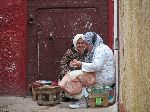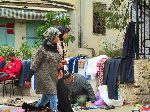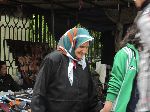|
Morocco:
Moyen Atlas Mountains Bicycle Africa / Ibike Tours |
|||
 |
Sefrou: Berber Village (and now town) | ||
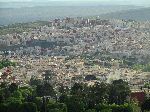 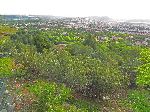 Sprawling
modern Sefrou is not what makes it historically noteworthy and a destination for
cultural tourism. Sprawling
modern Sefrou is not what makes it historically noteworthy and a destination for
cultural tourism. |
|||
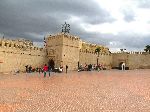 |
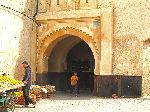 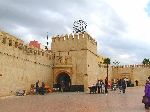 Reflecting
back to the recently visited communities; Midelt is a modern city, and Boulemane
is a French mountain village. In comparison, the core of
Sefrou is a walled, traditional Moroccan town. In 2013, it was recognized as a
UNESCO World Heritage Site. Reflecting
back to the recently visited communities; Midelt is a modern city, and Boulemane
is a French mountain village. In comparison, the core of
Sefrou is a walled, traditional Moroccan town. In 2013, it was recognized as a
UNESCO World Heritage Site. |
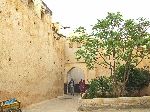 |
|
  The
medina is bisected by Oued Aggai. Unfortunately, the river is used as a dump. It
is filled with garbage for most of the year until the river "flushes"
itself with the spring
floods, and the town's trash starts it journey to becoming ocean garbage. The
medina is bisected by Oued Aggai. Unfortunately, the river is used as a dump. It
is filled with garbage for most of the year until the river "flushes"
itself with the spring
floods, and the town's trash starts it journey to becoming ocean garbage.Upstream from the medina is a small cascade (far right). It is more impressive in
the rainy season. |
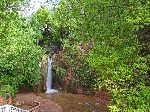 |
||
|
Historically, Sefrou enjoyed some economically stability and wealth because it was a major stopping point for traders making their way from the Mediterranean to the Sahara Desert. The legacy is a vigorous and colorful souks, a labyrinth of narrow streets, many riads, stately doors and a welcoming and relaxed street culture. |
|||

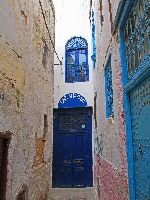
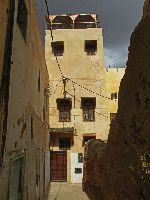
 |
|||
|
In the residential sections of the medina, narrow streets, with whitewashed
and natural exterior walls create a simple and clean look. . |
|||
 |
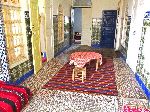 Typical
of North African architecture there is little emphasis on beautifying the
exterior of a building or landscaping the surrounding land. Instead, the emphasis
is on the interior, which is livened up with floor and wall tile work, colorful
woven rugs and hangings, interior windows, ironwork, cabinetry, and furniture.
The interior can become very garden-like. Typical
of North African architecture there is little emphasis on beautifying the
exterior of a building or landscaping the surrounding land. Instead, the emphasis
is on the interior, which is livened up with floor and wall tile work, colorful
woven rugs and hangings, interior windows, ironwork, cabinetry, and furniture.
The interior can become very garden-like.By incorporating courtyards (right)
into the architecture there is more open space in the medina than would be the
simple conclusion from walking the streets. |
 |
|
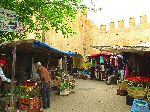 |
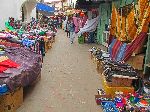

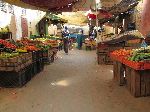
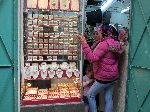 |
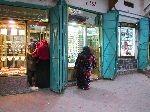 |
|
| The market has an inventory of a wide range of products: legumes, greens, tubers, fruits, grains, bread, pastries, multiple varieties of dates, clothes, head-to-toe accessories, footwear, scarves, hats, jewelry, house wares, and the list goes on. | |||
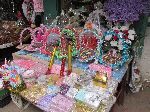 |
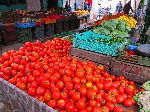
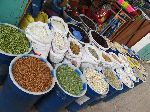
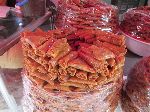
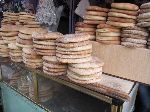 |
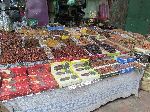 |
|
| Big doors go along with medinas and stately homes. Because we haven't seen behind the doors it not certain, but probable. | |||
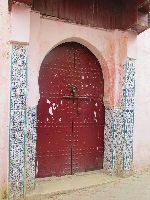
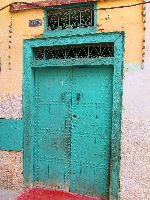
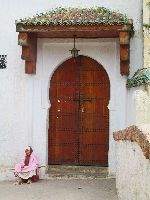
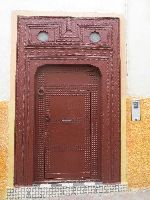 |
|||
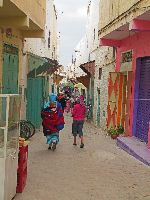 |
There are no parks and few public squares in the medina. Public squares are small and mostly occupied by vendors. Men tend to congregate in cafés. Women seemed to be the majority of shoppers and tended to congregate in the cul-de-sacs of the residential sections of the medina. |
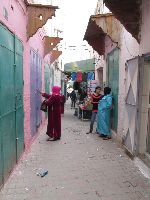 |
|
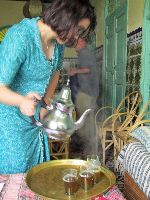 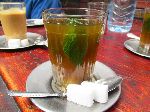 The
drink of preference in Sefrou seems to be mint tea, but coffee is also
available. Both are served with ample sugar. The
drink of preference in Sefrou seems to be mint tea, but coffee is also
available. Both are served with ample sugar. |
|||
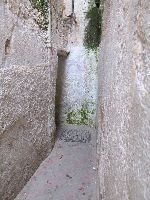 |
There was probably a Jewish presence before Islam was introduced in the 8th century. As a result, the trade routes the town became a melting pot of culture. The 13th century saw addition settling of Jewish Berber Moroccans and Algerians in Sefrou. The Jews lived together in Jewish quarters of towns call Mellah. These were characterized by few entrances, streets with pinch points that they were two people to pass and very low, long, dark passages near the entrance so one could ride a horse into the Mellah. All of these were subtle security measures. The architectural features of the Mellah that made way-finding for strangers difficult and made it easy to block off access if the Jewish inhabitants felt that they were in danger. Nowadays there is a mixed message about Morocco's Jewish community. People will proudly talk about how the Moslems and Jews in Morocco got along and the Mellah's in towns are known and remembered. But there are no museums to Moroccan Jewish culture and the Mellah is in disrepair, derelict and largely abandon. Most of Morocco's Jewish community left the country when the French departed in 1956. At the time, in Sefrou, it is estimated that there were 8000 members of the Jewish community -- one-third of the town population. Now only a few Jewish families remain. Causality is hard to attribute, but in the first half of the 20th century, Sefrou was said to have one of the most elegant medina's in the world. It has
declined significantly since then. It is still interesting but it would not be
described as elegant today. |
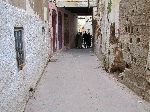 |
|
 At the edge of the medina is a hammam (Turkish bath). These are a feature of
most Moroccan and North African towns and cities. The man to the right is
stoking the furnace. This hamman seems to cater primarily to the local population.
In towns with larger tourism economies, hammans are being Westernized and
re-branded as spas.
At the edge of the medina is a hammam (Turkish bath). These are a feature of
most Moroccan and North African towns and cities. The man to the right is
stoking the furnace. This hamman seems to cater primarily to the local population.
In towns with larger tourism economies, hammans are being Westernized and
re-branded as spas. |
|||
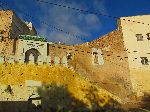
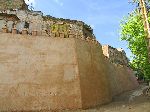

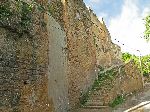 |
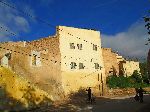 |
||
|
A half kilometer west of the Mellah, beyond the median wall, is El Kelaa,
another fortified community or ksar. Another physical remnant of the history of
Sefrou and Morocco. The high bastions speak to a more unstable period of North
African history. |
|||
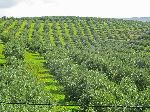 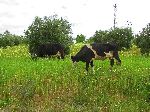 In
the Sefrou Province, out of Sefrou and back into the agricultural country, northwest
of town, toward Fes, the primary product is olives. There is mile after mile of
orchard rolling over the landscape. It would not be enter cropping if the
orchards are mixed with cows, but it is probably a symbiotic relationship. In
the Sefrou Province, out of Sefrou and back into the agricultural country, northwest
of town, toward Fes, the primary product is olives. There is mile after mile of
orchard rolling over the landscape. It would not be enter cropping if the
orchards are mixed with cows, but it is probably a symbiotic relationship. |
|||
| The graph displays the topography from Sefrou to Fes. How you view it would depend upon which direction you are traveling, in either direction the slopes are generally less than 3%. | |||
 [Depending upon the quality of the underlying data graphs maybe only general representations of the topography.] |
|||
|
|
|||
|
|
Unique Programs To Special Places For Memories Of A Lifetime!
"Hosted by
DreamHost - earth friendly web hosting"
|
|
